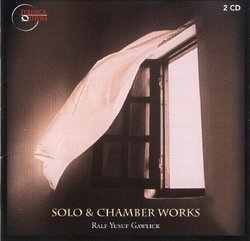| All Artists: Gloria Chien;piano;Jennifer Blyth;piano;Blanka Bednarz;violin;Nathaniel Farny;viola;Rafael Popper-Keizer;cello;Kanako Nishikawa;piano Title: Ralf Yusuf Gawlick - Solo & Chamber Works Members Wishing: 0 Total Copies: 0 Label: Musica Omnia Release Date: 2/15/2010 Genre: Classical Styles: Chamber Music, Historical Periods, Classical (c.1770-1830) Number of Discs: 2 SwapaCD Credits: 2 UPC: 801890030920 |
Search - Gloria Chien;piano;Jennifer Blyth;piano;Blanka Bednarz;violin;Nathaniel Farny;viola;Rafael Popper-Keizer;cello;Kanako Nishikawa;piano :: Ralf Yusuf Gawlick - Solo & Chamber Works
 | Gloria Chien;piano;Jennifer Blyth;piano;Blanka Bednarz;violin;Nathaniel Farny;viola;Rafael Popper-Keizer;cello;Kanako Nishikawa;piano Ralf Yusuf Gawlick - Solo & Chamber Works Genre: Classical Ralf Gawlick's debut collection for Musica Omnia comprises instrumental works for solo, duo, trio and quartet. A sophisticated interweaving of technique and imagination leads us on a pilgrimage through rich and varied musi... more » |
Larger Image |
CD Details
Synopsis
Product Description
Ralf Gawlick's debut collection for Musica Omnia comprises instrumental works for solo, duo, trio and quartet. A sophisticated interweaving of technique and imagination leads us on a pilgrimage through rich and varied musical landscapes of breath-taking intensity, enhanced by performances of remarkable virtuosity. Musicologist Elliott Antokoletz writes: Within the context of a larger body of contemporary music, Gawlick's works feature prominently as leading examples in a new era of concern for a multiplicity of concepts, styles, moods, and disciplines (e.g., philosophy, religion, psychology) conjoined within the musical sphere... In the Trio, the composer's motivic ingenuity serves to organize, together with the specific formal disposition of moods, the respective outer and inner movements into an overall symmetrical arch-shape. A similar concern for architectural design based on an intersection of structural components is seen in the Sonata-Mazur (Aus der Ferne...) for violin and piano. This work's rich musical discourse and evocative landscapes spring from the dramatic interaction of varying styles, gestures, fabrics, and poetic references. In addition to a confluence of styles and affects, a symbolic equilibrium in structure and design is further epitomized in the Mysterium doloris quintae (Tropen-Kreuz) for solo piano. It is in this work that Gawlick's musical intuition and intellectual acuity is manifested within a composite of historical musical sources. Quotations of Bach, Mozart and the songs of children from around the world help manifest the general symbolism of the Mysterium to focus an aural space into a figural image. This cross of interacting tropes serves to musically reveal the work's underlying message: a parallel between Christ's crucifixion with the sufferings of children. Similarly, the symbolism in Glocken-Spiel, for piano quartet, is based on the projection of a unity into associated diversities. This work combines and juxtaposes a host of instrumental sonorities which reveal the possibilities even in the twenty-first century of an original use of special string timbres and extended playing techniques to reflect a symbolism invoked by the bell tone: 'an anchor of constancy and regularity amidst uncertainty and inconstancy.' Ralf Gawlick's valuable contribution to contemporary music is evident not only in his highly original approach to sonority, structure, and design, but also in his many different spheres of interest that stem from or are associated with the composer's multifaceted musical world.
